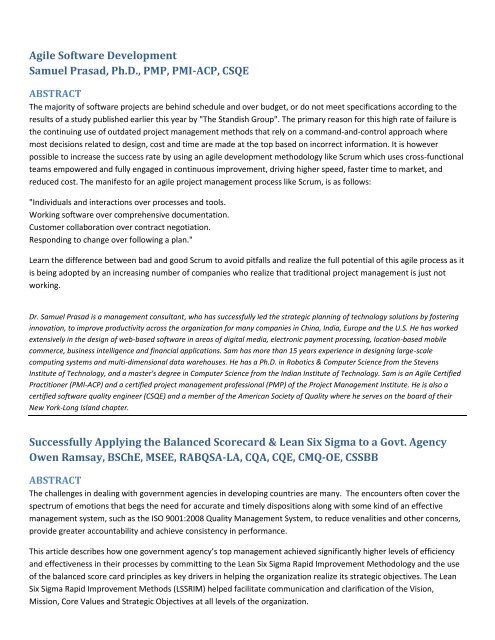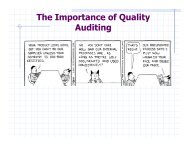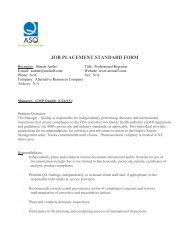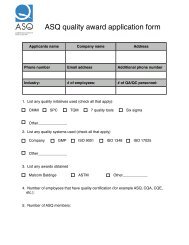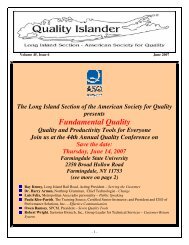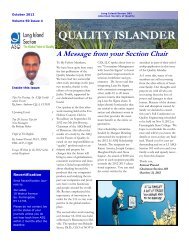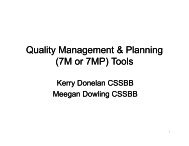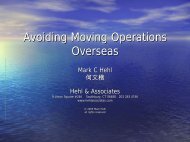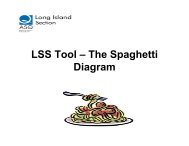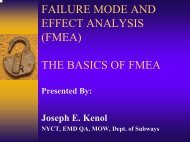Agile Software Development Samuel Prasad, Ph.D., PMP, PMI-ACP ...
Agile Software Development Samuel Prasad, Ph.D., PMP, PMI-ACP ...
Agile Software Development Samuel Prasad, Ph.D., PMP, PMI-ACP ...
You also want an ePaper? Increase the reach of your titles
YUMPU automatically turns print PDFs into web optimized ePapers that Google loves.
<strong>Agile</strong> <strong>Software</strong> <strong>Development</strong><br />
<strong>Samuel</strong> <strong>Prasad</strong>, <strong>Ph</strong>.D., <strong>PMP</strong>, <strong>PMI</strong>-<strong>ACP</strong>, CSQE<br />
ABSTRACT<br />
The majority of software projects are behind schedule and over budget, or do not meet specifications according to the<br />
results of a study published earlier this year by "The Standish Group". The primary reason for this high rate of failure is<br />
the continuing use of outdated project management methods that rely on a command-and-control approach where<br />
most decisions related to design, cost and time are made at the top based on incorrect information. It is however<br />
possible to increase the success rate by using an agile development methodology like Scrum which uses cross-functional<br />
teams empowered and fully engaged in continuous improvement, driving higher speed, faster time to market, and<br />
reduced cost. The manifesto for an agile project management process like Scrum, is as follows:<br />
"Individuals and interactions over processes and tools.<br />
Working software over comprehensive documentation.<br />
Customer collaboration over contract negotiation.<br />
Responding to change over following a plan."<br />
Learn the difference between bad and good Scrum to avoid pitfalls and realize the full potential of this agile process as it<br />
is being adopted by an increasing number of companies who realize that traditional project management is just not<br />
working.<br />
Dr. <strong>Samuel</strong> <strong>Prasad</strong> is a management consultant, who has successfully led the strategic planning of technology solutions by fostering<br />
innovation, to improve productivity across the organization for many companies in China, India, Europe and the U.S. He has worked<br />
extensively in the design of web-based software in areas of digital media, electronic payment processing, location-based mobile<br />
commerce, business intelligence and financial applications. Sam has more than 15 years experience in designing large-scale<br />
computing systems and multi-dimensional data warehouses. He has a <strong>Ph</strong>.D. in Robotics & Computer Science from the Stevens<br />
Institute of Technology, and a master's degree in Computer Science from the Indian Institute of Technology. Sam is an <strong>Agile</strong> Certified<br />
Practitioner (<strong>PMI</strong>-<strong>ACP</strong>) and a certified project management professional (<strong>PMP</strong>) of the Project Management Institute. He is also a<br />
certified software quality engineer (CSQE) and a member of the American Society of Quality where he serves on the board of their<br />
New York-Long Island chapter.<br />
Successfully Applying the Balanced Scorecard & Lean Six Sigma to a Govt. Agency<br />
Owen Ramsay, BSChE, MSEE, RABQSA-LA, CQA, CQE, CMQ-OE, CSSBB<br />
ABSTRACT<br />
The challenges in dealing with government agencies in developing countries are many. The encounters often cover the<br />
spectrum of emotions that begs the need for accurate and timely dispositions along with some kind of an effective<br />
management system, such as the ISO 9001:2008 Quality Management System, to reduce venalities and other concerns,<br />
provide greater accountability and achieve consistency in performance.<br />
This article describes how one government agency’s top management achieved significantly higher levels of efficiency<br />
and effectiveness in their processes by committing to the Lean Six Sigma Rapid Improvement Methodology and the use<br />
of the balanced score card principles as key drivers in helping the organization realize its strategic objectives. The Lean<br />
Six Sigma Rapid Improvement Methods (LSSRIM) helped facilitate communication and clarification of the Vision,<br />
Mission, Core Values and Strategic Objectives at all levels of the organization.
Last December the agency received the country’s Public Service Award of Excellence. The award recognized the<br />
agency’s accomplishments for:<br />
<br />
<br />
<br />
significantly reducing the lead times for six of its processes,<br />
achieving the coveted ISO 9001:2008 Certification in March 2011 and,<br />
exceeding customer satisfaction and performance goals.<br />
Owen Ramsay, President of Statistical Process Control Management Inc. (SPCM Inc.) is a Process Control and Process Management<br />
Consultant and is the 2008-2009 Gold Medal Award Chairman of the Long Island Section of the American Society for Quality (ASQ).<br />
He was recently appointed to the position of Global Outreach Chair for the Quality Management Division of ASQ with responsibility<br />
for raising awareness of the global scope of ASQ as a quality community.<br />
Mr. Ramsay has a BS in Chemical Engineering from the University of California Los Angeles, an MS in Electrical Engineering from<br />
Arizona State University, and holds ASQ certifications as a Six Sigma Black Belt in Advanced Quality Principles, Quality Engineer,<br />
Quality Auditor, and Quality Manager of Operational Excellence. He is also an ISO 9001:2008 Quality Management Systems RABQSA<br />
Lead Auditor.<br />
Mr. Ramsay successfully applies the Lean Six Sigma Rapid Improvement Methodologies (LSSRIM) to enhance process efficiencies,<br />
effectiveness, and customer satisfaction in the healthcare, manufacturing, process and service industries. He has also successfully<br />
used LSSRIM to guide government agencies to ISO 9001:2008 quality management system certification. LSSRIM draws from Lean<br />
Principles, the Six Sigma Methodology and the Environment, Relations & Core principles of the Baldrige Performance Excellence<br />
Award program.<br />
Using Lean tools for FOD Critical Compliance<br />
Brian Ascetta, BS, MBA, PE, CSSBB, NIST Certified Trainer in Lean Manufacturing<br />
ABSTRACT<br />
Does your operation have strict criteria for cleanliness, contamination control<br />
Challenge: Helicopter flight critical assembly operation is required to be compliant to NAS 412 “Foreign Object Damage”<br />
(FOD) Control.<br />
Apply the 5 Criteria:<br />
<br />
<br />
<br />
<br />
Tool accountability and control<br />
Hardware accountability and control<br />
Consumable accountability and control<br />
Clean as you go philosophy<br />
Control of personal effects<br />
Constraints:<br />
<br />
<br />
Learn:<br />
<br />
<br />
do not increase work force nor create dedicate work tasks<br />
cannot consume production floor space<br />
How the use of Lean Tools simplified the tasks for implementing and sustaining FOD compliance.<br />
How to implement cultural change to achieve the goal.
Brian Ascetta currently runs Continuous Process Improvement Corporation and is working with Sikorsky Corporation<br />
Education:<br />
BS, Industrial Engineering from Lehigh University<br />
MBA in Total Quality Management from Dowling College<br />
Licenses & Certification:<br />
ASQ certified Six Sigma Black Belt<br />
NIST certified trainer in Lean Manufacturing<br />
SME, AME, and Shingo Prize Certified Lean Bronze Sensei<br />
APICS Certified Supply Chain Professional<br />
NYS Licensed Professional Engineer, specializing in Mechanical Engineering<br />
Mr. Ascetta has over 25 years cross-functional experience in engineering, facilities, and production management. He has worked<br />
with Fortune 500 and smaller privately held companies.<br />
Experience<br />
Implemented Lean Manufacturing techniques for production operations resulting in increased through put and reduced lead<br />
times<br />
Conducted training seminars on Lean Manufacturing and Six Sigma<br />
Facilitated Kaizen events for production, maintenance and office operations, resulting in increased productivity and improved<br />
cash flow.<br />
Conducted Six Sigma projects to identify root causes and implement process improvements resulting in reduced lead times and<br />
improved in quality.<br />
Management as a Force Multiplier of Lean Six Sigma in Healthcare<br />
Bahadir Inozu, <strong>Ph</strong>.D.<br />
ABSTRACT<br />
This presentation focuses on why and how to effectively integrate Constraints Management with Lean and Six Sigma in<br />
today's healthcare environment of incessant change. Rather than a "one-size-fits-all" solution, this "best of the breed"<br />
approach advocates using the right tool, at the right time on the right problem. How to achieve maximum gains by<br />
directing improvement efforts at strategic leverage points will be described. Tactics to introduce basic and advanced<br />
Constraints Management concepts to Lean and Six Sigma cultures will be presented. Examples from healthcare<br />
applications will be discussed.<br />
"Baha" is chief executive officer and a co-founder of NOVACES. He is a Lean Six Sigma Master Black Belt and a Theory of Constraints<br />
Jonah. Prior to NOVACES, he served as Chairman and Professor of the School of Naval Architecture and Marine Engineering and<br />
Professor of Engineering Management at the University of New Orleans. He also served as the Director of the Reliability, Operations<br />
and Maintenance Division of the Gulf Coast Region Maritime Technology Center. He is credited with pioneering the integration of<br />
Lean Six Sigma in the U.S. shipbuilding industry through research sponsored by the Office of Naval Research. Currently, he is<br />
formulating the integration of Critical Chain Project Management, a groundbreaking approach to project improvement with<br />
Continuous Process Improvement. For over twenty years he has been a thought leader, conducting more than twenty major applied<br />
research projects and writing over seventy journal articles. His work includes the development of a computerized maintenance<br />
management system (CMMS) incorporating capabilities for reliability and availability analysis. Additionally, he created the world<br />
standard hierarchy of equipment boundaries for reliability performance data. He is the co-author of the book entitled "Performance<br />
Improvement for Healthcare: Leading Change with Lean, Six Sigma and Constraints Management". Dr. Inozu earned his M.S. and<br />
<strong>Ph</strong>.D. in Naval Architecture and Marine Engineering from the University of Michigan in 1986 and 1990 respectively. He received a<br />
B.Sc. in Mechanical Engineering from Istanbul Technical University.


